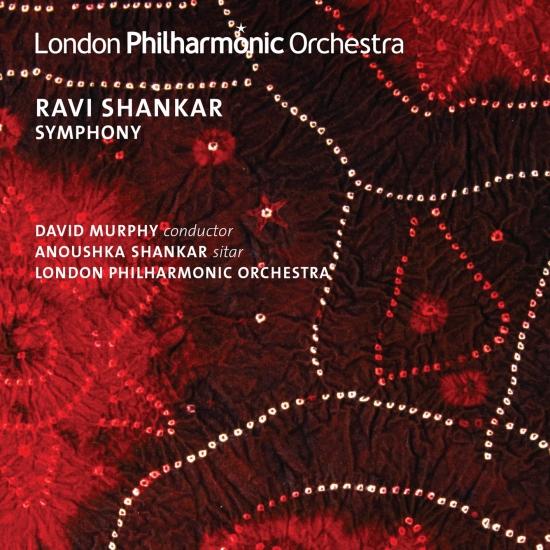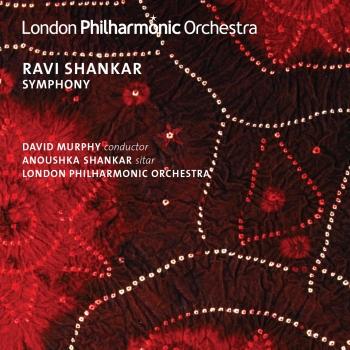
Shankar: Symphony London Philharmonic Orchestra, Anoushka Shankar & David Murphy
Album info
Album-Release:
2012
HRA-Release:
15.06.2019
Label: London Philharmonic Orchestra
Genre: Classical
Artist: London Philharmonic Orchestra, Anoushka Shankar & David Murphy
Composer: Ravi Shankar (1920-2012)
Album including Album cover Booklet (PDF)
- Ravi Shankar (1920 - 2012): Symphony:
- 1Symphony: I. Allegro - Kafi Zila09:21
- 2Symphony: II. Lento - Ahir Bhairav07:51
- 3Symphony: III. Scherzo - DoGa Kalyan08:48
- 4Symphony: IV. Finale - Banjara15:47
Info for Shankar: Symphony
Legendary composer and sitarist Ravi Shankar is one of India’s most highly esteemed musical ambassadors, renowned for his pioneering work in bringing Indian music to the West. 2010 saw the première of his ambitious fusion work, his first symphony conceived for a Western symphony orchestra, which translates the aural sensibilities and sound-worlds of Indian music into a Western structural framework. In this live recording of the work’s première, David Murphy conducts the London Philharmonic Orchestra with Ravi Shankar’s daughter Anoushka on sitar.
Ravi Shankar travelled a great deal in the West as a child dancer in his elder brother Uday Shankar’s troupe of Indian musicians and dancers. During a long sojourn in Paris in the early 1930s he met many of the legends of Western classical music: George Enescu, the great Romanian violinist and composer who was then teaching the teenage Menuhin in Paris. Toscanini, Heifetz, Paderewski, Casals, Kreisler and the great Russian bass Chaliapin were some of the musical legends who made an impact on the young Ravi Shankar.
He also experienced the reaction of Westerners to hearing Indian music for the first time. He noticed that the Western ear is attuned to harmony, modulation and counterpoint: musical textures which of necessity are almost entirely absent in Indian music in order to maintain the melodic purity of the raga. He realised Western-trained ears needed an awareness of the rhythmic and melodic structures underpinning Indian music in order to appreciate it.
Thus in later years, Ravi Shankar became the first Indian musician to explain these concepts to his audiences. Through Ravi Shankar, Indian music began to have an influence on most genres of Western music: Yehudi Menuhin became a duo partner and George Harrison was another Western musician for whom the music of India resonated deeply. Harrison became a devoted student and lifelong friend, thus the influence of Indian music reached out to a whole generation.
"It's a tremendously attractive, sometimes serene, often joyous work, drawing on Indian melodic and rhythmic elements, European structures and developmental procedures, and textures from both traditions...[Anoushka] performs with her accustomed charm, aplomb and panache. Credit should also go to the flautists, who are given important work to do." (BBC Music Magazine)
"it's a resounding triumph, from the vibrant, animated opening movement “Kafi Zila” through an elegant, involving lento section of duetting flute and sitar, and an intriguing Indian scherzo whose hypnotic layerings of marimba, flute and sitar evoke echoes of American minimalism, through to the stirring, virtuoso finale." (The Independent)
Anoushka Shankar, sitar
London Philharmonic Orchestra
David Murphy, conductor

Anoushka Shankar
To read a list of Anoushka Shankar’s accomplishments is to read many life stories in one: masterful sitarist; film composer; impassioned activist; the youngest and first female recipient of a British House of Commons Shield; the first Indian musician to perform live or to serve as presenter at the Grammy Awards with seven nominations under her belt, and the first Indian woman to be nominated; one of the first five female composers to have been added onto the UK A-level music syllabus. Immersed from a young age on the world stage, with over a quarter-century’s performing behind her, she is a singular, genre-defying artist across realms - classical and contemporary, acoustic and electronic.
The Shankar house, a respite from a world where she grew up under the public’s intense gaze, was seldom a silent place. Musicians were a permanent presence - learning, rehearsing, improvising, or simply playing musical games around the dinner table. Anoushka began studying the sitar - and Indian classical music - from the age of 9 under the intensive tutelage of her father, Pandit Ravi Shankar: a master of the instrument, and a figure without whom 20th Century music would quite simply not have been what it was. After making her professional debut at thirteen, she began touring worldwide alongside her father then embarked on a successful touring career when she was 18, becoming known for her virtuosic yet emotional playing style, unusual instrumentation, and precise rhythmic interplay. Having discovered electronic music as a teenager before later immersing herself in the Goan psychedelic trance scene, she found parallels with the meditative, introspective qualities of Indian classical music in the ecstatic release of the dancefloor: using different colours to paint the same picture.
Having released three classical albums for Angel Records EMI and performed at venues such as Carnegie Hall and the Barbican multiple times by the age of 25, the switch to earthy ambience and deep textures on 2005’s Rise was fuelled by a desire “to create music that more fully represents who I am.”
Self-composed and produced, and infused with electronics created alongside Gaurav Raina of the MIDIval Punditz, Rise “was a way to speak the language of my own history: growing up across three continents with one foot in the past and one in the present.”
Earning her a 2nd Grammy nomination, this cinematic album formed the blueprint for her intensive solo career. Notions of physical and sonic space are inverted; instruments flow into each other like merging streams; disparate systems of tuning, scale, and instrumentation are made to sound as if they were always meant to co-exist. Her follow-up album Breathing Underwater, created in collaboration with multi-instrumentalist Karsh Kale, envisioned a sonic world where ragas, bright analogue soundscapes, contemplative electronics, and guest turns by Ravi Shankar, Sting, and Anoushka’s half-sister Norah Jones could all slot next to each other without seeming an inch out of place.
Signing to Deutsche Grammophon in 2011 marked the start of a decade of unbridled fertility. Over the course of four distinct albums, each Grammy-nominated, disparate threads were woven into a tapestry, even as themes shifted and sound palettes expanded. Deep meditations of love and loss on the Nitin Sawhney-produced Traces Of You nestled against a quietly-triumphant return to pure raga improvisations on Home; the historical relationship between Indian classical music and Spanish flamenco was explored on the Javier Limón-produced Traveller whilst the current global refugee crisis informed the rallying cry of Land Of Gold. Co-written with frequent collaborator and handpan exponent Manu Delago and featuring M.I.A, Vanessa Redgrave and Alev Lenz, Land Of Gold crystallised Anoushka’s sound: a de-exotified, high-definition sitar resonating across unpredictable, genre-resistant instrumentation. Alev’s hypnotic presence is also felt on Love Letters - Anoushka’s most recent release, existing in its own universe. The co-produced EP contains startingly-beautiful turns by Ibeyi, Shilpa Rao and Ayanna Witter-Johnson and distills the raw emotions of each note, showcasing an artist who is increasingly comfortable with being vulnerable.
In a world market designed more for the solo auteur, those who grow up with an impulsive and collective music-making process may often find themselves at a loose end. Anoushka’s environment entrenched a liquid approach to composition and performance - letting the creative process itself provide clarity, and lighting the path ahead with the sparks of connection that develop. A love of that connection has drawn her to collaborate with diverse artists including Herbie Hancock, Patti Smith, Joshua Bell, Gold Panda, Rodrigo y Gabriela, Jules Buckley and His Holiness the Dalai Lama. Her touring career has taken her from legendary jazz cafes to iconic Symphony Halls and festival stages in front of 40,000 people, and her versatility transforms each of these locations into an intimate experience for all listening. That versatility comes out of years spent building the confidence to be artistically truthful and to connect to her audience from the heart.
Anoushka’s foray into composing for film birthed what she considers her most challenging piece of work: scoring the British Film Institute’s restoration of Shiraz, one of the first major Indian silent feature films, and performing it live at screenings. The flexibility of live performance is tethered by the technical exactitude of film, and the heavy weights of the histories and cultures being showcased, but also the ability to subvert audience expectations and not give in to any obvious signifiers. Her recent work co-composing the score to Mira Nair’s A Suitable Boy is a sonic portrait of post-partition India, showcasing how she can flit between the decades effortlessly whilst not compromising artistic integrity.
As her music speaks to timeless pasts and urgent futures, so she is just as tireless in her activism work. She has been outspoken about her experiences as a woman and a survivor of child abuse, throwing her weight behind campaigns such as One Billion Rising. She frequently works with organisations such as the UNHCR and Help Refugees to raise funds and awareness for the refugee crisis. In 2020 she was announced as the inaugural President of the F-List: a UK database created to help bridge the gender-gap in music, and as an Ambassador for The Walk: an international artistic project in support of refugees.
All of this speaks to a rare breed of artist; one who can balance many lives in one, each one seeming as natural as the next. Anoushka’s tempests of sound present ancient instruments in modern lights, not as exotic set pieces, but as living, breathing, and wildly expressive, full-bodied gifts to this world. Every note played comes from the soul, “playing to connect to the innermost part of my myself and hopefully the listener, evoking empathy or a feeling of hope…you have to believe you might make a difference in order to bother trying”.











